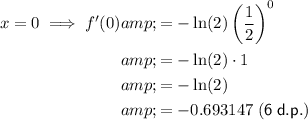Answer:
A. -0.693147
Explanation:
Replace f(x) with y in the given function:

Take natural logs of both sides of the equation:



Differentiate using implicit differentiation.
Place d/dx in front of each term of the equation:

Differentiate with respect to x:





Multiply both sides by y:

Substitute back in the expression for y:

Therefore, the differentiated function is:

To find f'(0), substitute x = 0 into the differentiated function:
